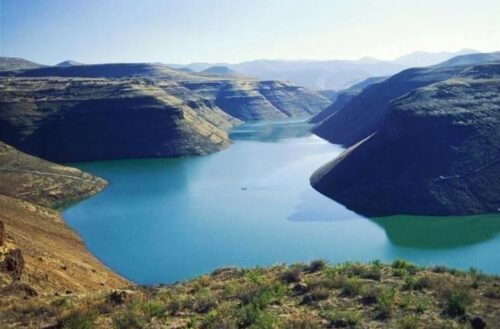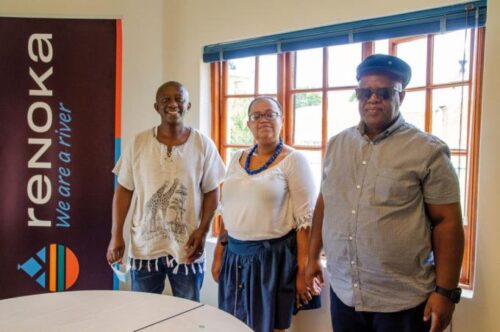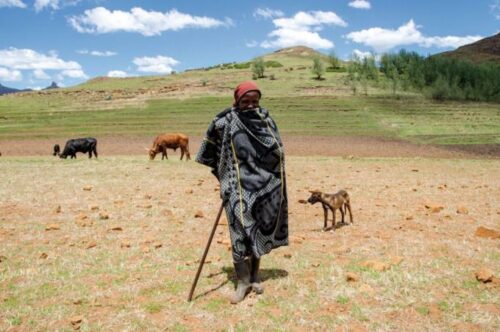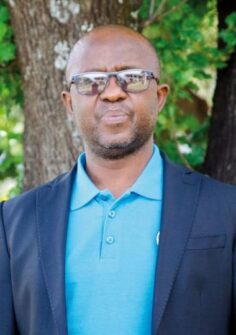Lesotho. The Troubled Waters.
The wealth generated by the abundance of water has not prevented the increasingly vulnerable country from suffering for decades from land degradation. The government, civil society, and rural communities, with the technical and financial support of the international community, is trying to tackle the problem.
Lesotho is known as the Kingdom of Heaven. Two thirds of its surface is mountainous and contains the highest peak in southern Africa, which is Mount Ntlenyana at 3,482 meters above sea level. Its 30,000 square kilometres are inhabited by just over two million people, with a per capita income ($1,187) five times lower than that of South Africa, despite having a natural resource essential for life: water.

About 90% of Lesotho’s wetlands are located in the northeast of the country.
Adjacent to the South African region of KwaZulu-Natal in the north, the Drakensberg mountain range stretches the length of the country, forming a plateau in the north ranging from 2,700 to 3,200 meters above sea level and which is vital for livestock and the agricultural industry. It is also the main source of the Tugela River, which flows east for over 500 kilometres, and the Orange River, which flows through the west of the country and is the most important river in South Africa.
The tributaries of the Caledon River flow along the 100km of Lesotho’s western border, between the Maloti Mountains and the South African Free State. On its highest peaks, it is possible to see snow even in summer; in winter, temperatures drop below -20°c and their waters drain into the Senqu River which feeds Namibia and Botswana.
According to the World Wildlife Fund, it is a bioregion – a space larger than an ecosystem – whose soil is composed of sandstone and shale and covered with basalt.
To protect land and water
The Orange, Tugela and Caledon tributaries are the source of much of southern Africa’s fresh water, but rural and commercially limited Lesotho is one of the least developed countries in the world – last of all on the Human Development Index, 165th out of 189. However, it lives alongside one of the continent’s largest economies, which also has a more accessible and useful topography for livestock and agriculture.
“The hills have an altitude of between 1,800 and 2,100 meters, which drops to 1,500 in the plain. The mountain soils are of basaltic origin, shallow but rich, while in the plain it is sandstone resulting in widespread erosion that has seriously damaged the whole territory”, explains Makomoreng Fanana, head of the Renoka movement, a name that means ‘We are one river’ which operates as a link between rural communities, civil society and the government to save both the land and the water that enriches the country.

From left: Makomoreng Fanana, Matsolo Migwi and Moteka Mohale, Renoka’s technicians and experts. (Photo: Carla Fibla García-Sala)
“Lesotho began to suffer from land decline before independence, but we have learned our lesson and we know that one institution alone cannot solve the problem; we need each other”, Fanana says, noting that his action is framed within the Department of Water Affairs, which is responsible for controlling water quality, quantity, sources and management. “The main source is the wetlands in territories managed by another ministry, but we must also take into account local government structures and tribal leaders. To declare a wetland as a protected area, we need to agree and understand why, for what purpose the decision
is made”, he continues.
About 90% of Lesotho’s wetlands are located in the northeast of the country and ensure that water flows along rivers and reaches other regions in the south of the continent. “Our goal is to manage and protect both land and water. But also, to improve the daily life of the communities where the sources of the river are located, ensuring economic development and sustainable use for the future, for the current generation and for those to come”, Fanana points out.

A shepherd watches over his cattle. (Photo Carla Fibla García-Sala)
Renoka’s manager says there have been several attempts to solve the land drainage problem, but they failed because “the approach was top-down, unbalanced and horizontal”, and success was limited to the duration of projects. “Now we are increasing awareness of what is happening and we are investing in behaviour change by developing community-based interventions”, Fanana says.
Mokake Mojakisane, who is the Commissioner for water and heads a major project Integrated Watershed Management (ICM) to combat land degradation says: “We share water with South Africa, Botswana and Namibia; the goal is that 70 cubic meters per second – currently 25 – are transferred from Lesotho to the Vaal River in South Africa, to contribute to 46% of flow capacity. In our program, we integrate the management of river basins because our country is severely degraded by the improper use of land, sources of resources, and can be harmful because we are a country with an abundant amount of water”. Mojakisane stresses that his country benefits from 50% of the hydroelectric energy consumed – the rest is imported from neighbouring countries. The Maseru government is contributing five million euros to the Integrated River Basin Management (ICM) project, which will be completed by the end of 2023.
Dependence on South Africa
Approximately 800 million cubic meters of water leave Lesotho for South Africa each year. This fresh water is not always available to communities living near dams due to access constraints.
This forces the local population to resort to unprotected sources, which often become a source of infections or outbreaks of diarrhoea due to the consumption of contaminated water.
According to the Lesotho Highlands Development Authority (LHDA), between 1996 and 2020 Lesotho earned 11.2 billion malotis (709.5 million euros) from the sale of 16,401 million cubic meters of drinking water to South Africa. In 2020 it was 65.6 million euros for 780 million cubic meters, in what the authorities of Lesotho and South Africa call ‘an example of successful regional cooperation’. On the ground, however, this has a minimal impact on the standard of living of the population, which sees its precious ‘white gold’ extracted daily.

Mokake Mojakisane, Commissioner for water. (Photo Carla Fibla García-Sala)
The Lesotho Highlands Development Authority (LHDA) is developing one of the most ambitious engineering projects in Africa, with the aim of collecting water – the average annual rainfall exceeds 1,000 l / m2 – from the main rivers of the country and creating large artificial lakes to store it. The water would then be channelled from the north into the rivers of South Africa to reach the dam on the Vaal River, on which the densely populated urban and industrial areas of Johannesburg and Pretoria depend. The initial idea dates back to the 1950s, but an agreement was signed only in 1986, the second phase of which began in 2000 when a sub-agreement was revised and signed that was no longer taken into consideration, although the initial agreement was for this to be done every 12 years.
“A profitable agreement with South Africa would involve raising the rates payable for water exploitation and, in social terms, to ensure that Lesotho does not consider the dams as the property of South Africa. The treaty should be revised to improve what we share, and its management must be totally in the hands of Lesotho because they are our natural resources, on which we depend”, explains Mojakisane.
At the same time, it is important to involve local communities in the various decision-making processes. “The communities are part of the Renoka movement, a program of change, and they are impatient for the interventions to start where they have not yet been implemented. They are ready, but we want the project to be their property, not imposed by Maseru. The chain works because the communities inform us who have the technicians; we identify the challenges with them, and they show us what these places were like. We identify the change and what needs to be done”, Fanana says, after explaining that they are trying to recover the ‘natural sponges’ that retain water in wetlands when it rains and then, in periods of drought, filter it into the ground, preventing
it from drying out.

It is important to involve local communities in the various decision-making processes.
According to preliminary studies by several international organizations, confirmed by Renoka, between 63% and 80% of wetlands in Lesotho
have been lost since 2015.
” We have no alternative but to act by implementing projects that produce results, like what we are doing with the European Union and other international organizations. We have shown that it is possible to reverse the degradation of some of the wetlands or to stop their deterioration by allowing the earth to rest and regenerate”, Fanana said.
Investments in awareness – understanding why waste needs to be removed, when and how to weed, collect stones that spread erosion and implement water harvesting techniques – and community involvement are keys to ending the rifts that pervade the country. Currently, the Mohokare, Makhaleng and Senqu river basins, which are home to six rivers, are implementing the ICM action plan which aims to ‘provide climate-resilient socio-economic development in Lesotho’. (Open Photo.123rf.com)
Carla Fibla García-Sala



